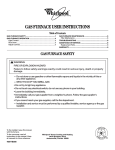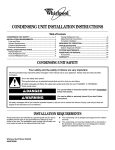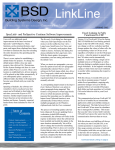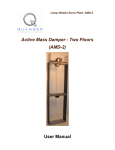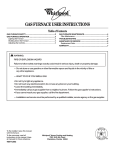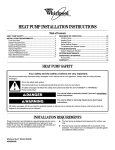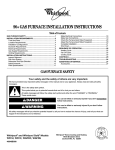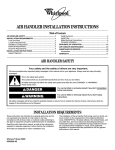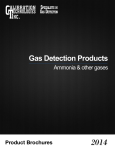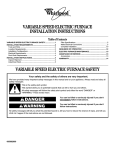Download Whirlpool WAHMS Instruction manual
Transcript
AIR HANDLER INSTALLATION INSTRUCTIONS Table of Contents AIR HANDLER SAFETY .................................................................1 INSTALLATION REQUIREMENTS ................................................2 Tools and Parts ............................................................................2 System Requirements..................................................................2 Location Requirements ................................................................2 Installation Configurations ...........................................................3 Drain Pan Connections ................................................................4 Electrical Requirements— Models Without Factory-Installed Electric Heat ..........................5 Electrical Requirements— Models With Factory-Installed Electric Heat ...............................6 Ductwork Requirements ..............................................................6 INSTALLATION INSTRUCTIONS ..................................................6 Inspect Shipment .........................................................................6 Install Condensate Drain..............................................................7 Install Ductwork............................................................................8 Verify Orifice Size .........................................................................8 Connect Refrigerant Lines ...........................................................8 Make Electrical Connections— Models Without Factory-Installed Electric Heat ..........................9 Make Electrical Connections— Models with Factory-Installed Electric Heat ..............................10 Complete Installation..................................................................14 SEQUENCE OF OPERATION ......................................................21 Cooling (Cooling Only or Heat Pump)........................................21 Heating (Electric Heat Only) .......................................................21 Heating (Heat Pump) ..................................................................21 Variable Speed Features ............................................................21 AIR HANDLER MAINTENANCE ..................................................22 ASSISTANCE OR SERVICE .........................................................22 Accessories ................................................................................22 WARRANTY ..................................................................................23 AIR HANDLER SAFETY Your safety and the safety of others are very important. We have provided many important safety messages in this manual and on your appliance. Always read and obey all safety messages. This is the safety alert symbol. This symbol alerts you to potential hazards that can kill or hurt you and others. All safety messages will follow the safety alert symbol and either the word “DANGER” or “WARNING.” These words mean: DANGER WARNING You can be killed or seriously injured if you don't immediately follow instructions. You can be killed or seriously injured if you don't follow instructions. All safety messages will tell you what the potential hazard is, tell you how to reduce the chance of injury, and tell you what can happen if the instructions are not followed. Whirlpool® Models WAHMS, WAHMV 065937402 INSTALLATION REQUIREMENTS These instructions are intended as a general guide only for use by qualified persons and do not supersede any national or local codes in any way. Compliance with all local, state, or national codes pertaining to this type of equipment should be determined prior to installation. Read this entire instruction manual, as well as the instructions supplied in separate equipment, before starting the installation. All models are designed for indoor installation only. The installation of the air handler, field wiring, warm air ducts, etc. must conform to the requirements of the National Electrical Code, ANSI/NFPA No. 70 (latest edition) in the United States, and any state laws, and local ordinances (including plumbing or wastewater codes). Local authorities having jurisdiction should be consulted before installation is made. Such applicable regulations or requirements take precedence over the general instructions in this manual. Install the conditioned air plenum, ducts and air filters (not provided) in accordance with NFPA 90B Standard for the Installation of Warm Air Heating and Air-Conditioning Systems (latest edition). The air handler is provided with flanges for the connection of the plenum and ducts. Air filters (not provided) must be listed as Class 2 furnace air filters. The air handler can be used with R-22 or R410A from the factory. The air handler is shipped from the factory completely assembled. Some models are configured for upflow air discharge only, and some models are configured for upflow or horizontal left-hand air discharge. The air handler cabinet conforms to 2 percent or less air leakage. Do not remove the cabinet knockouts until it has been determined which knockouts will need to be removed for the installation. Select the final installation position which best suits the site conditions. Consider required clearances, space, routing requirements for refrigerant line, condensate disposal, filters, ductwork, wiring, and accessibility for service. Refer to the air handler rating plate on the air handler for specific information. Tools and Parts Gather the required tools and parts before starting installation. Read and follow the instructions provided with any tools listed here. Tools Needed ¹⁄₄" nut driver ■ ■ Level ■ Hammer ■ Screwdriver ■ Sealant ■ Adjustable wrench ■ Parts Needed Check local codes, check existing electrical supply, and read “Ductwork Requirements,” and “Electrical Requirements,” before purchasing parts. Tape measure ■ UL listed wire nuts ■ Replacement orifice (if needed). See “Verify Orifice Size.” The correct orifice size may be contained in the replacement orifice package located inside the control box of the outdoor unit. If this package does not contain the correct orifice for your air handler, you must purchase the correct orifice size. System Requirements The air handler is designed to match, and must be used with outdoor units as rated. The indoor units are manufactured with an interchangeable refrigerant metering orifice to provide optimum refrigerant control and system performance with a variety of different capacities of outdoor units. In some cases, the rating of the outdoor unit may require that the air handler coil assembly orifice be changed to obtain rated performance. Location Requirements WARNING NOTE: When used on cooling applications, excessive sweating may occur when the air handler is installed in a very humid space. ■ If installed in an unconditioned space, sealant should be applied around the electrical wires, refrigerant tubing, and condensate lines where they enter the cabinet. ■ Electrical wires should be sealed on the inside where they exit the conduit opening. Sealant is required to prevent air leakage into and condensate from forming inside the air handler, control box, and on electrical controls. ■ The air handler must be installed in such a way as to allow free access to the coil/filter compartment and blower/control compartment. ■ The air handler must be installed in a level position to ensure proper condensate drainage. Explosion Hazard Keep flammable materials and vapors, such as gasoline, away from air handler. Place air handler so that heating elements are at least 18 inches (46 cm) above the floor for a garage installation. Failure to follow these instructions can result in death, explosion, or fire. 2 18" and 24" models 320 sq. in. Non-Ducted Return Closet Installation 30" and 36" models 360 sq. in. The air handler can be installed in a closet with a false bottom to form a return air plenum or be installed with a return air plenum under the air handler. Louvers or return air grilles are field supplied. Local codes may limit application of systems without a ducted return to singlestory buildings. ■ For an air handler installed in a closet with a louvered return opening, the minimum open area for the louvers will be as shown below. 42", 48" and 60" models 450 sq. in. Installation Clearances ■ If the free area is not known, assume a 25% free area for wood or a 75% free area for metal louvers or grilles. ■ Using the louver dimensions and the 25% or 75% assumption, determine if the louver open area meets the minimum open area listed above. ■ If the return air plenum is used, the return air grille should be immediately in front of the opening in the plenum to allow for the free flow of return air. ■ When not installed in front of the opening, there must be adequate clearance around the air handler to allow for the free flow of return air. Installation Configurations For ease in installation, it is best to make any necessary coil configuration changes before setting air handler in place. See “Installation Configuration Options.” ■ Upflow air discharge only contains 1 drain pan. ■ Upflow or horizontal airflow contains 2 drain pans. Vertical Installations Upflow The air handler must be supported on the bottom only and set on a field-supplied supporting frame with an air return opening. Securely attach the air handler to the supporting frame. Suspended Cabinet Installation NOTE: Air handlers cannot be installed horizontally lying on or suspended from either the front or back of the air handler. It must be positioned with one side parallel to the floor when in the horizontal position. The suspending means must be field fabricated, and should consist of 2 “cradles” made by attaching 2 rods to a length of angle iron or suitable gauge steel. Installation Configuration Options Shading indicates proper line connections Upflow As shipped from the factory (return in bottom) Horizontal Installations Horizontal installations can be left-hand or right-hand air supply. Adequate support must be provided to ensure cabinet integrity. Ensure that there is adequate room to remove, service and access panels if installing in the horizontal position. For correct horizontal coil installation, see “Installation Configuration Options” later in this section. IMPORTANT: ■ This coil is provided with a secondary drain that should be trapped and piped to a location that will give the occupant a visual warning that the primary drain is clogged. See “Install Condensate Drain.” ■ When an evaporator coil is installed in an attic or above a finished ceiling, an auxiliary drain pan should be provided under the air handler as specified by most local building codes. Conversion from Vertical to Horizontal An upflow only air handler may be converted to horizontal air discharge by installing a horizontal drain pan kit. See “Accessories.” An upflow/horizontal air handler may be converted from horizontal left-hand discharge to horizontal right-hand discharge without additional parts. A A B C B A. Horizontal drain connections (left or right hand) B. Upflow drain connections C. Bottom/filter frame 3 . Horizontal Right Horizontal Left Left to Right Airflow: Requires drain pan location change. Factory ready (on some models) Drains Drains A C B A A. Drain connections B. Coil access cover C. Blower access cover A. Drain connections Drain Pan Connections Horizontal Installations can be either “Right” or “Left.” For Horizontal Right Installations, a drain pan location change is required. Use drain connections marked “A” below. Conversion to Horizontal Right Before Conversion Horizontal Right Left to Right Airflow: Requires drain pan location change. A Drains B G A C A. Drain connections For Horizontal Left Installations, use drain connections marked “A” below. F E Horizontal Left D Factory ready (on some models) A. Blower B. Top cap C. Coil/drain pan assembly (consists of coil, bottom drain pan and side drain pan) Drains C B A. Drain connections B. Coil access cover C. Blower access cover 4 A D. Coil support bracket E. Filter access door F. Bottom drain pan G. Side drain pan 1. Remove screws from the blower access cover and lift off of the air handler. Set aside. 2. Remove screws from the coil access cover and lift off of the air handler. Set aside. 3. Remove screws from the coil support bracket and lift off of the air handler. Set aside. 7. Install the coil support bracket on the opposite side of the air handler. NOTE: For models 2.5 tons to 5 tons, the bracket attached to the top cap will need to be switched to the opposite side of the coil. This is to prevent blowoff in the horizontal position when the airflow is changed from left-hand to right-hand. After Conversion A B C A D E G A. Coil support bracket screws 4. Remove the coil/drain pan assembly by lifting and sliding out. The assembly consists of the coil, the bottom drain pan and the side drain pan. 5. Remove the side drain pan from the coil/drain pan assembly and install on the opposite side. 6. Reinstall the coil/drain pan assembly in the same orientation as before by lifting and sliding into the air handler. F A. Blower B. Top cap C. Coil/drain pan assembly (consists of coil, bottom drain pan and side drain pan) D. Side drain pan E. Bottom drain pan F. Filter access door G. Coil support bracket 8. Determine knockouts required for drain line connections and remove. 9. Replace the blower and coil access covers. Electrical Requirements—Models Without Factory-Installed Electric Heat WARNING NOTES: ■ Use copper conductors only. ■ All field wiring must be done in accordance with National Electrical Code, applicable requirements of UL and local codes where applicable. ■ Electrical wiring, disconnect means and overcurrent protection are to be supplied by the installer. Refer to the air handler rating plate for maximum overcurrent protection, minimum circuit ampacity, as well as operating voltage. ■ The power supply must be sized and protected according to the specifications supplied on the product. ■ This air handler is factory-configured for 120-volt or 240-volt, single phase, 60 cycles. For 208-volt applications, see “208-Volt Conversion” in the “Make Electrical Connections— Models Without Factory-Installed Electric Heat” section. ■ For optional electric heater applications, see “Accessories.” Refer to the instructions provided with the accessory for proper installation. Electrical Shock Hazard Electrically ground air handler. Connect ground wire to ground terminal marked “GND”. Failure to do so can result in death or electrical shock. 5 Electrical Requirements—Models With Factory-Installed Electric Heat NOTES: ■ Use copper conductors only. WARNING Electrical Shock Hazard ■ All field wiring must be done in accordance with National Electrical Code, applicable requirements of UL and local codes where applicable. ■ Electrical wiring, disconnect means and overcurrent protection are to be supplied by the installer. Refer to the air handler rating plate for maximum overcurrent protection, minimum circuit ampacity, as well as operating voltage. ■ The power supply must be sized and protected according to the specifications supplied on the product. ■ This air handler is factory-configured for 240-volt, single phase, 60 cycles. For 208-volt applications, see “208-Volt Conversion” in the “Make Electrical Connections—Models Without Factory-Installed Electric Heat” section. Electrically ground electric heater. Connect ground wire to ground terminal marked “GND.” Use copper wire rated for supply connection. Correct wire gauge is shown in the chart below. Failure to follow these instructions can result in death or electrical shock. Rating Plate Ampacity AWG 21 - 30 10 31 - 40 8 41 - 60 6 Ductwork Requirements ■ Install the conditioned air plenum, ducts and air filters (not provided) in accordance with NFPA 90B Standard for the Installation of Warm Air Heating and Air-Conditioning Systems (latest edition). ■ The air handler is provided with flanges for the connection of the plenum and ducts. ■ The air handler is equipped with flanges that can form a filter rack for the installation of the air filter, or the filter may be installed as part of the return air duct system. ■ Air filters must be listed as Class 2 furnace air filters. ■ Supply and return ductwork must be adequately sized to meet the system’s air requirements and static pressure capabilities. Ductwork should be insulated with a minimum of 1" thick insulation with a vapor barrier in conditioned areas or 2" minimum in unconditioned areas. ■ Supply plenum should be the same size as the flanged opening provided around the blower outlet and should extend ideally at least 3 ft from the air handler before turning or branching off plenum into duct runs. The plenum forms an extension of the blower housing and minimizes air expansion losses from the blower. INSTALLATION INSTRUCTIONS Inspect Shipment WARNING Excessive Weight Hazard Use two or more people to move and install air handler. Failure to do so can result in back or other injury. These air handlers are completely factory assembled, and all components are performance tested. Each air handler consists of a blower assembly, refrigerant coil, and controls, in an insulated galvanized steel factory finished enclosure. Knockouts are provided for electrical wiring entrance. 6 1. Check the air handler rating plate to confirm specifications are as ordered. 2. Upon receipt of air handler, thoroughly inspect it for possible shipping damage. Closely examine the air handler inside the carton if the carton is damaged. If damage is found, it should be noted on the carrier’s freight bill. Damage claims should be filed with the carrier immediately. Claims of shortages should be filed with the seller within 5 days. NOTE: If any damages are discovered and reported to the carrier, do not install the air handler because your claim may be denied. 3. Connect primary drain line connection to the primary drain pan connection. The primary drain connection is flush with the bottom of the inside of the pan. Secondary connection is raised above the bottom of the inside of the pan. NOTE: When making drain fitting connections to the drain pan, hand tighten. Using a sealant is recommended. Overtightening the fittings can split connections on the drain pan. 4. Secondary drain connections, if used, should be connected to a separate drainage system. Run the secondary drain line to a place where the occupant would notice if water started coming from the secondary drain. 5. Install a 3" trap in both the primary and secondary drain lines as close to the unit as practical. Make sure the top of the trap is below the connection to the drain pan to allow complete drainage of the pan. NOTE: Horizontal runs must also have an anti-siphon air vent (standpipe) installed ahead of the horizontal run. See “Typical Condensate Drain Connection” in this section. An extremely long horizontal run may require an oversized drain line to eliminate air trapping. Typical Condensate Drain Connection (secondary drain not shown) B A If a filter is to be installed at the air handler, remove the 2 screws from the filter access panel and slide in the appropriate filter. See the Filter Size Chart to ensure that the correct filter is installed. C D 1.00" Min. 12.00"Max. Filter Size Chart 3.00" Min. Model Filter Size 18 / 24 16" x 20" 30 / 36 18" x 20" 42 / 48 / 60 18" x 25" Install Condensate Drain The air handler is provided with ³⁄₄" NPT condensate drain connections. A field-fabricated secondary drain pan, with a drainpipe to the outside of the building, is required in all installations over a finished living space or in any area that may be damaged by overflow from the main drain pan. In some localities, local codes may require an secondary drain pan for any horizontal installation. Make sure the air handler is level so that the drain pan will empty completely. 1. Remove the appropriate drain knockouts. See “Drain Pan Connections” section. You may need to remove the indoor coil assembly from the cabinet. 2. Remove any web from inside any threaded drain pan hole to which a drain line is to be connected. Gently remove the web so as not to damage the coil. E F A. Air handler B. Drain connection C. Drain line D. Anti-siphon air vent E. Drain trap F. Auxiliary drain pan NOTE: Do not operate air handler without a drain trap. The condensate drain is on the negative pressure side of the blower; therefore, air being pulled through the condensate line will prevent positive drainage without a proper trap. 6. Route the drain line to the outside or to an appropriate drain. Drain lines must be installed so they do not block service access to the front of the air handler. A 24" clearance is required for filter, coil, or blower removal and service access. NOTE: Check local codes before connecting the drain line to an existing drainage system. 7. Insulate the drain lines where sweating could cause water damage. Test condensate drain pan and drain line after installation: 1. Pour several quarts of water into drain pan, enough to fill drain trap and line. 2. Check to make sure the drain pan is draining completely, no leaks are found in drain line fittings, and water is draining from the end of the primary drain line. 3. Correct any leaks found. 7 Install Ductwork IMPORTANT: ■ Install ductwork in accordance with NFPA 90B Standard for the Installation of Warm Air Heating and Air-Conditioning Systems (latest edition) and any local codes. ■ Connect supply air duct to the flange on top of the air handler. If an isolation connector is used, it must be nonflammable. ■ A return air duct system is recommended. If the air handler is installed in a confined space or closet, the entire duct cross sectional area must meet minimum return air free area. Verify Orifice Size NOTE: Some models are equipped with thermal expansion valve and do not require any orifice change. 1. Consult the outdoor unit literature to determine whether the indoor unit has the correct orifice installed. 2. If a change of the orifice is required, loosen the brass hex nut and separate the orifice extension stub from the brass hex fitting. A B C A D G A. Distributor fitting B. Piston orifice C. Ring seal (supplied) D. Orifice extension stub A. Thermal expansion valve For factory installed thermal expansion valves, attach sending bulb to suction line with strap. Bulb should be positioned 1 ft or less from the header connection and situated at the 4 o’clock or 8 o’clock position. Secure tightly and cover with cork or foam insulation. IMPORTANT: The proper orifice size is dependent on indoor coil/ outdoor unit combination and application. E F E. 0.812" brass hex nut F. Brass hex fitting G. Mounting flange 3. Remove the orifice with an orifice extractor tool. 4. Insert the proper orifice into the fitting, seal end first. Make sure the orifice is free to move in the fitting. 5. Replace the brass hex nut. NOTE: Overtightening the brass hex nut will crush the gasket and may result in a system leak or stuck piston. 6. Dispose of/recycle all packaging and unused parts. Connect Refrigerant Lines Refrigerant lines must be connected by a licensed, EPA certified refrigerant technician in accordance with established procedures. IMPORTANT: ■ Connecting refrigerant lines must be clean, dehydrated, refrigerant-grade copper lines. Air handler coils should be installed only with specified line sizes for approved system combinations. ■ Handle the refrigerant lines gently during the installation process. Sharp bends or possible kinking in the lines will cause a restriction. ■ Do not remove the caps from the lines or system connection points until connections are ready to be completed. 1. Route the suction and liquid lines from the fittings on the indoor coil to the fittings on the outdoor unit. Run the lines in as direct a path as possible avoiding unnecessary turns and bends. 8 2. Make sure that the suction line is insulated over the entire exposed length and that both suction and liquid lines are not in direct contact with floors, walls, ductwork, floor joists, or other piping. 3. Connect the suction and liquid lines to the evaporator coil. 4. To avoid damaging the rubber grommets in the cabinet while brazing, slide the rubber grommets over the refrigerant lines until they are away from the heat source. 5. Braze with an alloy of silver or copper and phosphorus with a melting point above 1,100°F. NOTE: Do not use soft solder. 6. Reinstall the rubber grommets after brazing is finished. 7. Make sure air handler has been put in place according to the Installation Instructions and is connected to the refrigerant lines. Make Electrical Connections—Models Without Factory-Installed Electric Heat 240-Volt Installations A B WARNING C GND Electrical Shock Hazard Disconnect all power supplies before servicing. Replace all parts and panels before operating. Failure to do so can result in death or electrical shock. 1. Disconnect all power supplies. 2. Remove the blower access panel. 3. Route the field supply wires to the air handler electrical connection box. 4. Using UL listed wire nuts, connect the field supply wires to the air handler (black to black and yellow to yellow). A. Yellow wire B. Black wire C. Ground terminal marked “GND” 6. Replace the blower access panel. 208-Volt Conversion WARNING Electrical Shock Hazard Disconnect all power supplies before servicing. Replace all parts and panels before operating. Failure to do so can result in death or electrical shock. WARNING 1. Disconnect all power supplies. 2. Remove the air handler access panel. 3. Move the 2 connected black transformer leads from the 240-volt terminal on the transformer to the 208-volt terminal on the transformer. See “Wiring Diagram—Electric Heat and Blower” in the “Make Electrical Connections—Models with Factory-Installed Electric Heat” section. Electrical Shock Hazard Electrically ground air handler. Connect ground wire to ground terminal marked “GND”. Failure to do so can result in death or electrical shock. 5. Connect ground wire to ground terminal marked “GND.” 9 Make Electrical Connections—Models with Factory-Installed Electric Heat WARNING Connect to Circuit Breaker 60 OFF GND 60 Electrical Shock Hazard 208/230 Volt Field Supply Wires OFF Field Supply Ground Wires ON NOTE: There are 2 ground terminals marked “GND” shown here. There may be 1, 2 or 3 ground terminals depending on the number of circuit breakers. L1 Disconnect all power supplies before servicing. Circuit 1 ON L2 Replace all parts and panels before operating. Failure to do so can result in death or electrical shock. L1 1. Determine the number of circuits needed to supply the heater with electrical power (1, 2, or 3 circuits). See the air handler Accessory Kit label for number of circuits and ratings. 2. Disconnect all power supplies. 3. Knock out the correct number of knockouts (1, 2, or 3), and install UL listed wires and fittings. 4. Connect appropriate size wire to the circuit breaker terminals. If circuit breakers are not provided, a terminal block is provided. L2 Circuit 2 Connect to Terminal Block GND L2 L2 WARNING 208/230 Volt Field Supply Wires L1 L1 Field Supply Ground Wires Electrical Shock Hazard Electrically ground electric heater. Connect ground wire to ground terminal marked “GND.” Use copper wire rated for supply connection. Correct wire gauge is shown in the chart below. Failure to follow these instructions can result in death or electrical shock. Rating Plate Ampacity AWG 21 - 30 10 31 - 40 8 41 - 60 6 5. Connect green ground wire(s) (1, 2, or 3) to ground terminal(s) (1, 2, or 3) marked “GND.” 10 6. Install conduit opening plugs in any unused openings. 7. If circuit breakers or pull disconnects are used, the front panel knockouts will need to be removed. 8. Reinstall the air handler blower access panel. 9. Reconnect power. 10. Dispose of/recycle all remaining parts. Low Voltage Connections Thermostat Air Handler Thermostat Air Handler Heat Pump Unit R R G G BU BU W BK Condensing Unit Cooling Only Application Thermostat Air Handler R G Connect common wire only if required. See thermostat installation instructions. W Heat Pump Application with Electric Heat BK BU Thermostat Air Handler R G W Condensing Unit Heat Only Application Cooling Application with Electric Heat 11 Wiring Diagram—Blower (PSC Motor) 4 5 6 14 Y L2 18 BK 208V 240V BK W1 W C BU G G R R 18 R 24V COM W2 18 BU (H) 3 5 (H) TR C 2 TD ** 1 6 5 4 5 6 Wiring Diagram - No Heat ++ 14 BU (MED) 14 R (LO) BWR 14 BK (HI) 14 Y (COM) GND BR / W BU R BK MTR BR CAP Y+ 4 3 2 1 2 ++ 3 Wire Nuts by Others 3 4 2 ** TD = Time Delay (Optional) TR = Transformer BWR = Blower Relay MTR = Blower Motor CAP = Motor Capacitor GND = Ground Connection 18 G 14 R 18 BU 1 1 1 6-Pin Plug Models 12, 25, 31 and 49 Will Be Factory Set to Low. L1 L2 or Neutral 14 G 24 Control Circuit Wiring to be 24 Volt, N.E.C. Class 2 Plug Pin Amp 350781 - 1 Location 6-Pin Cap 14 Y (240V) 3 W: White G: Green Y: Yellow 14 BK 2 1 14 BK L1 BK: Black R: Red BU: Blue To Thermostat by Others Power (Factory Wired) Power (Field Wired) Control (Factory Wired) Control (Field Wired) 15 Amp Supply Voltage 2 To Ground Lug Wiring Diagram—Optional Electric Heat GND 220 208 / 240 Voltage by Others 1 12 BK LS4 12 Y 12 Y HE3 3 18 BU L2B 5 1st Stage SEQ1 *CB1 5 12 BK 12 BK L1A L2A 3 4 12 BK LS1 1 12 BK LS2 12 Y HE2 12 BK 12 BK HE4 L1B 2nd Stage 18 BK 4 12 BK LS3 1 12 3 4 18 W 18 BU 14 R GND To Blower 2 Ground Lug 14 G 14 Y 14 BK 12 Y 5 6 6-Pin Plug HE1 SEQ2 CB2 Heaters Used: 5 KW = HE1 7.5 & 10 KW = HE1 & HE2 15 KW = HE1, HE2 & HE3 20 KW = HE1, HE2, HE3 & HE4 * TB = Terminal Block (Optional) * CB = Circuit Breaker (Optional) SEQ = Sequencer GND = Ground Lug LS = Limit Switch HE = Heater Element Power (Factory Wired) Power (Field Wired) Control (Factory Wired) Control (Field Wired) Wiring Diagram—Blower (Variable Speed Motor) 6-Pin Plug 3 4 Power (Factory Wired) Control (Factory Wired Transformer Blower Motor Ground Connection Blower Relay 18 W 18 BK 5 6 18 BU L2 14 Y 14 R L1 2 14 BK 1 TR MTR GND BWR Control Board TR R 24V R 18 BU C1 18 BU EM 18 BK C1 18 W W1 O 18 OR Y2 18 BU/W Y1 18 Y G 18 G 16-Pin Plug & Cap 18 W 240 BWR 18 G GND W2 O Y2 Y1 G W1 18 BR (16) 18 BK 240V R Thermostat 208V 24V BU 24V R 18 Y COM Hum 18 R 18 R 5-Pin Plug 18 BK 5 18 Y 4 3 2 1 16-Pin Plug & Cap MTR 5-Pin Cap 13 Complete Installation NOTE: Refer to outdoor unit installation instructions for system start-up instructions and refrigerant charging instructions. Pre-Start Check ■ Is air handler properly located, level, secure, and serviceable? ■ Has an auxiliary pan been provided under the air handler with separate drain for air handlers installed above a finished ceiling or in any installation where condensate overflow could cause damage? Have all webs been removed from the drain connections that are being used? Have all drain pan plugs not used been properly plugged? ■ ■ Has the condensate line been properly sized, run, trapped, pitched, and tested? ■ Is the ductwork correctly sized, run, taped, and insulated? ■ Have all cabinet openings and wiring been sealed? ■ Is the indoor coil orifice size correct? ■ Have all unused orifice replacement parts and packaging been disposed of? ■ Is the filter clean, in place, and of adequate size? ■ Is the wiring neat, correct, and in accordance with the wiring diagram? ■ Is the air handler properly grounded and protected (fused)? ■ Is the thermostat correctly wired and in a good location? ■ Are all access panels in place and secure? Check Blower Operation (PSC Motor) Check Airflow Cooling blower speed ■ For proper cooling operation, the airflow through the indoor coil should be between 350 and 450 CFM per ton of cooling capacity (or 350 - 450 CFM per 12,000 Btu/h) based on the rating of the outdoor unit. ■ The cooling blower speed is factory configured to provide correct airflow for an outdoor unit that matches the maximum cooling capacity rating of the air handler. ■ If the outdoor unit is smaller than the maximum cooling capacity rating for the air handler, the cooling blower speed may need to be changed. Refer to Blower Performance Chart. IMPORTANT: The cooling blower speed must be set to provide a minimum of 350 CFM airflow per ton (1,200 Btu/h) of outdoor cooling capacity. WARNING Electrical Shock Hazard Disconnect all power supplies before servicing. Replace all parts and panels before operating. Failure to do so can result in death or electrical shock. 1. Set thermostat to FAN ON. 2. The indoor blower should come on. Check Electric Heater (if used) 1. Set thermostat to call for auxiliary heat (approximately 5°F above ambient temperature). The indoor blower and auxiliary heat should come on together. Allow a minimum of 3 minutes for all sequencers to cycle on. 2. Set the thermostat so it does not call for heat. Allow up to 5 minutes for all sequencers to cycle off. To change blower speed: Refer to “Wiring Diagram— Blower (PSC Motor). 1. Disconnect all power supplies. 2. Remove the air handler access panel. 3. Locate pin number 2 on the blower relay. Two black wires are connected to this terminal pin. One connects to pin number 5 on the blower relay, one connects to an inline splice connecting to a red or blue wire. 4. Remove the wire going to the 4-pin blower motor connector from the splice. 5. Connect the blower lead (Red [LO], Black [HI]) onto the splice from the 4-pin blower motor connector. NOTE: Unused blower speeds are shipped from the factory covered with a plastic cap. Remove this cap from the new blower speed terminal and replace it over the factory-set blower terminal. 6. Replace all panels. 7. Reconnect power. 14 Blower Performance Chart Air Handler Blower Model Speed 18 24 CFM @ ESP. - in. W.C. 0.1 0.2 0.3 0.4 0.5 Low* (Red) 655 647 628 578 480 Med (Blue) 794 786 747 672 555 High (Black) 1,074 1,000 913 809 672 Low (Red) 655 647 628 578 480 Med* (Blue) 794 786 747 672 555 High (Black) 1,074 1,000 913 809 672 860 851 842 813 721 Med* (Blue) 1,020 1,006 1,003 963 886 High (Black) 1,199 1,195 1,182 1,121 1,033 1,120 1,112 1,079 995 Low (Red) 30 Check Airflow (Variable Speed Motor) Low* (Red) 1,135 For proper cooling operation, the airflow through the indoor coil should be between 350 and 450 CFM per ton of cooling capacity (or 350 - 450 CFM per 12,000 Btu/h) based on the rating of the outdoor condensing unit. IMPORTANT: The cooling blower speed must be set to provide a minimum of 350 CFM airflow per ton (12,000 Btu/h) of outdoor cooling capacity. To change blower speed: Refer to “Wiring Diagram— Blower (Variable Speed Motor).” WARNING Electrical Shock Hazard Disconnect all power supplies before servicing. 36 42 48 60 Med (Blue) 1,354 1,345 1,317 1,260 1,090 High (Black) 1,494 1,469 1,417 1,336 1,250 Low (Red) 1,202 1,192 1,160 1,116 998 Med* (Blue) 1,404 1,413 1,386 1,303 1,192 High (Black) 1,540 1,530 1,507 1,386 1,254 Low (Red) 1,593 1,582 1,526 1,444 1,318 Med* (Blue) 1,759 1,709 1,636 1,538 1,395 High (Black) 1,886 1,820 1,742 1,606 1,446 Low (Red) 1,782 1,755 1,672 1,554 1,393 Med* (Blue) 2,066 1,960 1,860 1,714 1,476 High (Black) 2,109 2,067 1,949 1,770 1,586 Replace all parts and panels before operating. Failure to do so can result in death or electrical shock. 1. Disconnect all power supplies. 2. Locate the control board in the blower control box. 3. Set the HEAT and COOL taps by moving the board jumpers to the A, B, C, or D positions (see Control Board Taps and Dehumidify Resistor) based on the information found in the Blower Performance Chart—Variable Speed Motor. NOTE: If using a humidistat, the dehumidify resistor located on the bottom right of the control board must be removed to enable it. See Control Board Taps and Dehumidify Resistor. The HUM terminal on the board must be connected to the Normally Closed contact of the humidistat so that the board senses an open circuit on high humidity. If a humidistat is used, the dehumidify LED (see D1 below) will light when the humidistat opens and the motor runs at reduced airflow. All data given while air handler is operating with a wet DX coil and no air filter installed. Speeds marked with an asterisk (*) are the factory settings for both heating and cooling. Cooling speeds should not be reduced below factory settings. Different speeds can be set for heating mode. 15 Control Board Taps and Dehumidify Resistor 4. If desired, adjust ADJUST tap from NORM: (+) will increase airflow by 10% or (-) will decrease airflow by 12% 5. Reconnect all power supplies. . ADJUST NORM (+) (–) TEST HEAT COOL A B C D A B C D D1 A DEHUMIDIFY B CUT TO ENABLE A. Dehumidify LED B. Dehumidify resistor Application Table—Variable Speed Motor The versatility of the variable speed motor enables the performance of the BCS2 with variable speed to be tailored to the different modes of operation encountered in heating and cooling All BCS2's with variable speed are capable of operation at more than one nominal airflow rate. The operation of a variable blower at different airflow rates is determined by the control board taps and the thermostat (see the Application Table). Before Application Table—Variable Speed Motor Model Mode Control Board Taps Energized Thermostat Terminal Cool HUM EM A B C D A B C D CFM CFM CFM CFM CFM CFM CFM CFM 400 350 350 350 X 800 700 600 400 X 800 700 600 400 X *** *** *** *** 800 800 600 600 *** *** *** *** 800 800 600 600 600 500 400 350 X 1,200 1,000 800 600 X 1,200 1,000 800 600 X *** *** *** *** 1,200 1,200 800 800 *** *** *** *** 1,200 1,200 800 800 W1 O Y2/Y1 G WAHMV24 Continuous Blower Cooling X ** X Heating Auxillary Heat X Emergency Heat X X WAHMV36 Continuous Blower Cooling X ** X Heating Auxillary Heat Emergency Heat 16 beginning the setup, become familiar with the information found in this table. The data in the application table is categorized by unit size and mode of operation. Use the information provided to determine the CFM taps needed for cooling and heating. X X X Heat Application Table—Variable Speed Motor Model Mode Control Board Taps Energized Thermostat Terminal Cool HUM EM A B C D A B C D CFM CFM CFM CFM CFM CFM CFM CFM 700 600 500 400 X 1,400 1,200 1,000 800 X 1,400 1,200 1,000 800 X *** *** *** *** 1,400 1,400 1,000 1,000 *** *** *** *** 1,400 1,400 1,000 1,000 800 700 600 500 X 1,600 1,400 1,200 1,000 X 1,600 1,400 1,200 1,000 X *** *** *** *** 1,600 1,600 1,200 1,200 *** *** *** *** 1,600 1,600 1,200 1,200 900 800 700 600 X 1,800 1,600 1,400 1,200 X 1,800 1,600 1,400 1,200 X *** *** *** *** 1,800 1,600 1,400 1,200 *** *** *** *** 1,800 1,600 1,400 1,200 W1 O Y2/Y1 G WAHMV42 Continuous Blower Cooling X ** X Heating Auxillary Heat X X Emergency Heat X WAHMV48 Continuous Blower Cooling X ** X Heating Auxillary Heat X Emergency Heat X X WAHMV60 Continuous Blower Cooling X ** X Heating Auxillary Heat Emergency Heat X X X Heat **Humidistat will reduce cooling airflow by 10% in high humidity. ***Airflow is greater of Cool and Heat when both electric heat and heat pump are operating. NOTES: ■ Adjust the Control Board Tap (+) will increase airflow by 10%, while the Control Board Tap (-) will decrease airflow by 12%. ■ Adjust the Control Board Tap (-) test will cause the motor to run at 70% of full airflow. Use this for troubleshooting only. ■ At the start of a call for cooling, there is a short run at 82% of airflow for 7.5 minutes. ■ At the end of a call for cooling, there is a blower delay of 1 minute. 17 Blower Performance Chart—Variable Speed Motor The versatility of the variable speed motor enables the air handler to tailor its performance to the different modes of operation encountered in heating and cooling. All variable speed air handlers are capable of operation at more than one nominal airflow rate. The operation of a variable speed air handler blower at different airflow rates is determined by the control board taps and the thermostat. See the Blower Performance Chart—Variable Speed Motor. Before beginning the setup, become familiar with the information found in the Blower Performance Chart—Variable Speed Motor. The data in the Blower Performance Chart—Variable Speed Motor is categorized by model size and mode of operation. Use the information provided to determine the CFM taps needed for cooling and heating. Blower Performance Chart—Variable Speed Motor CFM @ E.S.P. - inches W.C. Air Handler Model Energized Thermostat Terminal Control Board Tap 0.1 0.2 0.3 0.4 0.5 0.6 0.7 0.8 WAHMV24 Y1 A 540 550 550 550 560 560 570 560 B 470 490 490 500 500 500 490 490 C 420 420 410 430 430 430 430 410 D 270 270 300 280 270 250 240 240 A 770 790 790 790 800 800 810 800 B 670 700 700 710 710 710 700 700 C 600 600 590 610 610 610 610 590 D 390 390 420 400 380 360 340 340 A 390 400 400 400 400 400 410 400 B 340 350 350 360 360 360 350 350 C 300 300 300 310 310 310 310 300 D 200 200 210 200 190 180 170 170 A 820 830 850 850 870 870 870 870 B 700 700 700 690 700 710 710 700 C 570 560 560 560 550 550 540 520 D 440 420 390 390 370 360 360 340 A 1,170 1,180 1,210 1,210 1,240 1,240 1,240 1,240 B 1,000 1,000 1,000 990 1,000 1,010 1,010 1,000 C 810 800 800 800 790 780 770 740 D 630 600 560 550 530 520 510 480 A 590 590 610 610 620 620 620 620 B 500 500 500 500 500 510 510 500 C 410 400 400 400 400 390 390 370 D 320 300 280 280 270 260 260 240 Y1/Y2 G WAHMV36 Y1 Y1/Y2 G 18 Blower Performance Chart—Variable Speed Motor CFM @ E.S.P. - inches W.C. Air Handler Model Energized Thermostat Terminal Control Board Tap 0.1 0.2 0.3 0.4 0.5 0.6 0.7 0.8 WAHMV42 Y1 A 920 970 970 970 980 990 990 1,000 B 830 830 840 850 850 850 850 850 C 690 700 700 700 710 710 720 710 D 570 570 570 580 580 590 570 550 A 1,320 1,380 1,380 1,390 1,400 1,410 1,410 1,430 B 1,180 1,180 1,200 1,210 1,220 1,220 1,220 1,220 C 990 1,000 1,000 1,000 1,020 1,020 1,030 1,020 D 810 810 810 830 830 840 820 790 A 660 690 690 700 700 710 710 720 B 590 590 600 610 610 610 610 610 C 500 500 500 500 510 510 520 510 D 410 410 410 420 420 420 410 400 A 1,120 1,120 1,130 1,140 1,130 1,130 1,130 1,140 B 960 970 970 980 990 990 990 1,000 C 830 830 830 830 840 850 850 830 D 690 700 710 710 710 710 710 690 A 1,600 1,600 1,610 1,630 1,620 1,620 1,620 1,630 B 1,370 1,380 1,390 1,400 1,420 1,420 1,410 1,430 C 1,190 1,190 1,190 1,190 1,200 1,210 1,210 1,190 D 990 1,000 1,020 1,010 1,010 1,020 1,010 990 A 800 800 810 820 810 810 810 820 B 690 690 700 700 710 710 710 720 C 600 600 600 600 600 610 610 600 D 500 500 510 510 510 510 510 500 Y1/Y2 G WAHMV48 Y1 Y1/Y2 G 19 Blower Performance Chart—Variable Speed Motor CFM @ E.S.P. - inches W.C. Air Handler Model Energized Thermostat Terminal Control Board Tap 0.1 0.2 0.3 0.4 0.5 0.6 0.7 0.8 WAHMV60 Y1 A 1,250 1,270 1,270 1,300 1,290 1,290 1,290 1,280 B 1,120 1,120 1,130 1,130 1,140 1,130 1,130 1,130 C 990 990 990 980 980 970 960 970 D 840 850 850 850 840 850 930 820 A 1,780 1,810 1,820 1,850 1,840 1,840 1,840 1,830 B 1,600 1,600 1,610 1,610 1,630 1,620 1,610 1,610 C 1,410 1,420 1,410 1,400 1,400 1,390 1,380 1,380 D 1,200 1,220 1,220 1,210 1,200 1,210 1,190 1,170 A 890 910 910 930 920 920 920 920 B 800 800 810 810 820 810 810 810 C 710 710 710 700 700 700 690 690 D 600 610 610 610 600 610 600 590 Y1/Y2 G NOTES: ■ All performance chart data given while air handler is operating with dry coil. ■ Humidistat will reduce cooling airflow by 10% in high humidity. ■ Adjust the Control Board Tap (+) will increase airflow by 10%, while the Control Board Tap (-) will decrease airflow by 12%. ■ Adjust the Control Board Tap (-) test will cause the motor to run at 70% of full airflow. Use this for troubleshooting only. ■ At the start of a call for cooling, there is a short run at 82% of airflow for 7.5 minutes. ■ At the end of a call for cooling, there is a blower delay of 1 minute. 20 SEQUENCE OF OPERATION Cooling (Cooling Only or Heat Pump) When the thermostat calls for cooling, the circuit between R and G is completed, and the blower relay is energized. The Normally Open contacts close, causing the indoor blower motor to operate. The circuit between R and Y is also completed; this circuit closes the contactor in the outdoor unit starting the compressor and outdoor fan motor. Circuit R and O energizes the reversing valve, switching it to the cooling position. (The reversing valve remains energized as long as selector switch is in the COOL position.) Heating (Electric Heat Only) When the thermostat calls for heat, the circuit between R and W is completed, and the heat sequencer relay is energized. A time delay follows before the heating elements and the indoor blower motor come on. Units with a second heat sequencer relay can be connected with the first sequencer to W on the thermostat subbase or connected to a second stage on the subbase. Heating (Heat Pump) When the thermostat calls for heat, the circuits between R and Y and R and G are completed. Circuit R-Y energizes the contactor starting the outdoor fan motor and the compressor. Circuit R and G energizes the blower relay starting the indoor blower motor. If the room temperature should continue to fall, the circuit between R and W 1 is completed by the second stage heat room thermostat. Circuit R-W 1 energizes a heat sequencer relay. The completed circuit will energize supplemental electric heat (if available). Units with a second heat sequencer relay can be connected with the first sequencer to W 1 on the thermostat or connected to a second heating stage W 2 on the thermostat subbase. Variable Speed Features Some WAHMV air handlers are equipped with a variable speed motor and will deliver a constant airflow within a wide range of external static pressures. The variable speed blower offers the following comfort features: Start When called into operation, the variable speed motor will slowly ramp up to normal operating speed. This eliminates the noise and discomfort that results caused by the initial blast of air encountered with standard air handlers. It can take up to 7.5 minutes to reach normal operating speed. Continuous Blower Operation The comfort level of the living space can be enhanced when using this feature by allowing continuous circulation of air in between calls for cooling or heating. The circulation of air between calls for cooling or heating occurs at 50% of the normal airflow rate (350 CFM minimum). Reduced Airflow Operation For situations where humidity control is a problem, the variable speed motor can be enabled to operate at a 10% reduction in the normal airflow rate under the control of a humidistat. This can be achieved by connecting to a standard humidity control that is normally closed and opens on humidity rise. The Control Board The control board regulates airflow selection and features LED indicators that display operating mode, humidity control, and airflow CFM. The red LED flashes once for each 100 CFM. For example, if the operating CFM is 1200, the CFM LED will flash 12 times, then pause before repeating the 12-flash pattern. Thermostat signals for emergency heat (EM), optional auxiliary heat (W1), reversing valve (O), compressor (Y1), and blower (G) are all indicated by lit LED’s on this board. This model is designed for use with heat pumps as well as air conditioning systems. The control board needs to sense a signal on the “O” thermostat wire in order to use cooling delay timing. For a straight air conditioning system, connect the “O” wire to the thermostat “R” wire. 21 AIR HANDLER MAINTENANCE IMPORTANT: Do not operate system without a filter. A filter is required to protect the coil, blower, and internal parts from excessive dirt and dust. See “Installation Configurations” for the location of the filter in the unit cabinet and the service panel giving access to unit filter. The filter is placed in the supply air return duct by the installer. ■ Inspect air filters at least once a month and replace or clean as required. Dirty filters are the most common cause of inadequate heating or cooling performance. ■ Replace disposable filters. Cleanable filters can be cleaned by soaking in mild detergent and rinsing with cold water. ■ Install new/clean filters with the arrows on the side pointing in the direction of airflow. ■ Do not replace a cleanable (high velocity) filter with a disposable (low velocity) filter unless return air system is properly sized for it. ■ If water should start coming from the secondary drain line, a problem exists which should be investigated and corrected. Contact a qualified person. ASSISTANCE OR SERVICE If you need further assistance, you can write to the below address with any questions or concerns: Whirlpool® Home Cooling and Heating 14610 Breakers Drive Jacksonville, FL 32258 Please include a daytime phone number in your correspondence. Accessories To order accessories, contact your local dealer with the appropriate part number listed below. Description Part Number 5kw with Pigtail Ends 654984-01 5kw with Terminal Block 654984-02 5kw with Circuit Breaker 654984-03 7.5kw with Circuit Breaker 654984-04 7.5kw with Terminal Block 654984-05 10kw with Terminal Block 654984-06 10kw with Circuit Breaker 654984-07 15kw with Circuit Breaker 654984-09 20kw with Circuit Breaker 654984-11 Downflow Kit (1.5, 2, 2.5 & 3 ton) 658731-75 Single Point Breaker Kit for 2 Stage 110001055 Single Point Breaker Kit for 3 Stage 110001054 Electric Heat Kits Refer to the accessory kit label on the front panel of the air handler for electric heat kit accessory options and applications. Horizontal Drain Pan Kit 22 Size Part Number 18 / 36 65873110 42 / 48 65873111 60 65873112 23 Keep this book and your sales slip together for future reference. You must provide proof of purchase or installation date for in-warranty service. Write down the following information about your air handler to better help you obtain assistance or service if you ever need it. You will need to know the complete model and serial number. You can find this information on the air handler rating plate. Dealer name____________________________________________________ Address ________________________________________________________ Phone number __________________________________________________ Model number __________________________________________________ Serial number __________________________________________________ Installation date ________________________________________________ 065937402 © 2007. All rights reserved. ®Registered Trademark/TM Trademark of Whirlpool, U.S.A., Manufactured under license by Tradewinds Distributing Company, LLC., Coconut Grove, Florida 11/07 Printed in U.S.A.

























